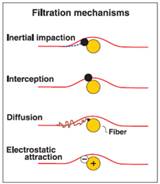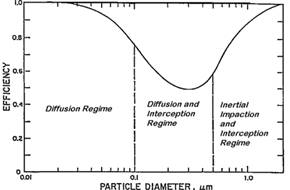Protecting Your Lungs from Viruses
Background
To understand the importance of protecting your lungs from viruses, you first have to understand more about viruses and how filter masks and respirators work.
Viruses are amongst the smallest infectious agents. While not inside an infected cell or in the process of infecting a cell, viruses exist in the form of independent particles, or virions. Most virus species have virions too small to be seen with an optical microscope, about one hundredth the size of most bacteria. Viruses typically range in size from approximately 0.040 micron to 0.300 micron. The SARS coronavirus was in the range of 0.100-0.130 micron. The recent Novel Coronavirus (2019-nCoV) has been measured in the range of 0.080-0.140 micron.
Masks are primarily indicated for people with coronavirus infections to minimize or eliminate the aerosolization of viral particles in the air from their breath or during coughing. The best ways to protect your lungs from inhaling viral particles is to stay away from any environment where there are people with viral infections. Alternatively, if you must be in that area, wearing a tight-fitting mask that filters out fine particles is critical.
What type of respirator filters viral particles?
When you are looking for a mask that filters viral particles, it doesn’t mean that you only want to filter particles that small. You also want to filter particles that are larger, that might be carrying a viral particle on it. Therefore, you want a respirator that filters a wide range of particles down to virus size and has been tested at 0.1 micron.
How does a respirator filter mask work?
There are several mechanisms for a respirator mask to stop particles from penetrating through the filter while still allowing the air you need to breathe to get into your lungs. Most respirators stop particles by either electrostatic attraction (i.e., the particles stick to the mask) or by inertial impaction (the particles slam into the fibers and get stuck). The other two mechanisms include particle interception and diffusion. (See Figure 1). It takes a combination of these mechanisms to provide the maximum protection.
Figure 1 Filtration Mechanisms
 Very large particles in slow moving airstreams may settle out due to gravity. However, most respirable particles are too small for this mechanism. Respirable particles above 0.6 um in diameter may be captured by interception and inertial impaction. Inertial impaction occurs when a particle cannot follow a streamline around a fiber because of its inertia and instead impacts into the fiber. In the interception mechanism, the particle holds to the streamline, but that streamline will naturally bring the particle close enough to come in contact with the fiber.
Very large particles in slow moving airstreams may settle out due to gravity. However, most respirable particles are too small for this mechanism. Respirable particles above 0.6 um in diameter may be captured by interception and inertial impaction. Inertial impaction occurs when a particle cannot follow a streamline around a fiber because of its inertia and instead impacts into the fiber. In the interception mechanism, the particle holds to the streamline, but that streamline will naturally bring the particle close enough to come in contact with the fiber.
In contrast, diffusion mainly affects particles under 0.1 micron. Random movements of air molecules cause these very small particles to wander across streamlines due to Brownian motion until they come in contact with a fiber. Because of the complex methods by which particulate filtration occurs, the smallest particles are not always the most difficult to filter. Electrostatic attraction is an entirely different particulate capture mechanism. Although it may be difficult to quantify the charge on either the particle or the fiber, electrostatic attraction can be an extremely effective means of capture. A charged particle will be attracted to fiber that has an opposite charge. In addition, a charged particle or fiber will induce an electrostatic field that will further serve to draw the two together.
Figure 2 Filtration Efficiency vs Particle Size
 Figure 2 shows the interaction of the different capture mechanisms on one type of filter media for the purpose of illustration. Filtration efficiency is shown as a function of particle diameter. While the filtration efficiencies are not representative of actual filters used in respirators today, it does demonstrate that most particulate filters have a region of minimum filtration efficiency somewhere between 0.05-0.5 micron. Particles in this range are too large to be effectively pushed around by diffusion and too small to be effectively captured by interception or impaction.
Figure 2 shows the interaction of the different capture mechanisms on one type of filter media for the purpose of illustration. Filtration efficiency is shown as a function of particle diameter. While the filtration efficiencies are not representative of actual filters used in respirators today, it does demonstrate that most particulate filters have a region of minimum filtration efficiency somewhere between 0.05-0.5 micron. Particles in this range are too large to be effectively pushed around by diffusion and too small to be effectively captured by interception or impaction.
As it turns out, the particle size that is the hardest to attract by electrostatic charge or diffusion mechanisms and also the hardest to stop by impaction or interception, is a particle that is 0.3 micron in diameter. As the smaller particles such as viruses enter the mask fiber structure, the electrostatic charge on the fibers attracts the particles and they stick to it. Since the fibers in the mask are not lined up so there is a single channel through the mask, the air has to flow and change direction many times in that short distance between the outside surface and your airway. As the larger particles make the turns to follow the air, they crash (impact) on the fibers and get stuck, never entering your breathing space inside the mask. As previously stated, the 0.3 micron is not too small and not too large. It is just right to get through most filters. That is why respirators are tested to see how well they can filter out 0.3 micron particles. If they can filter these particles, they are considered to be the most effective for filtering all particles in the air pollution small particle range. So you can see from this figure, viruses are not that difficult to filter if all the air you breathe is through the mask.
Can Respirators filter all small particles?
Two factors affect how efficient a respirator is at filtering the air you breathe. No disposable respirator can filter 100% of all particles because it is not just a matter of how good the filter is. The facial seal of facemasks is THE most important factor in protecting your lungs. Many respirators are not designed to seal well to your face so the reason that you find particles in your nose after using many masks is that there is no seal around the edges to your face (particularly prevalent with flat surgical masks). Particles get drawn into the mask from the edges and into your breathing zone. You might as well not be wearing any mask. This is even more critical to protect yourself against viruses in the air. With the silicone seal of our mask, you know that when you seal the mask to your face and test the seal, all of the air is being filtered.
However, even with a good seal, the mask will only filter a minimum of 95% of particles that are drawn into the mask surface. So there are still a small number of particles that can get past the protection of the mask. When there is a choice, you should always avoid contaminated areas. When there is no choice, there is no better selection for a mask to protect your lungs from virus particles than ours.
Conclusion
While no mask can completely protect your lungs, knowing what particles are in the air around you and their particle size, can assist you in making the right decision to wear the right mask. And independent of the filtration capability of the mask, the seal against your face is the most import aspect to assure. Whenever you are in an environment where other people may have viral infections, you should be wearing a mask that can demonstrate that it filters small particles (~0.1 micron) and seals well to your face. Remember to protect your lungs and your health.

